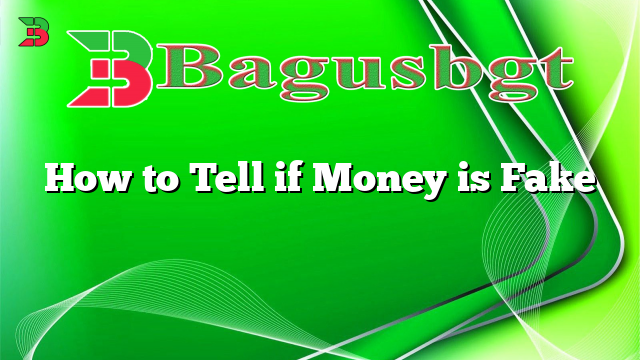Hello and welcome to our comprehensive guide on how to determine if money is counterfeit. In today’s world, where counterfeit currency is becoming increasingly prevalent, it is crucial to be able to identify fake money to ensure the integrity of our financial transactions. In this article, we will provide you with valuable insights and expert tips to help you spot counterfeit money. Let’s dive in!
1. Watermark
One of the most common security features found on legitimate currency is a watermark. Hold the bill up to the light, and you should see a faint image of the figure depicted on the bill. Counterfeiters often struggle to replicate this feature accurately, so a missing or poorly defined watermark can be a strong indicator of fake money.
2. Security Thread
Legitimate banknotes typically have a thin, embedded security thread running vertically through the bill. This thread can be seen when held up to the light and usually contains text or a pattern that is visible from both sides of the note. Counterfeit money may lack this security feature or have a thread that is simply printed on the surface.
3. Color-Shifting Ink
Many genuine banknotes use special ink that changes color when tilted. This color-shifting ink is challenging to replicate, making it an excellent indicator of counterfeit money. Tilt the bill back and forth to observe if the ink shifts from one color to another.
4. Raised Print
Authentic banknotes have a distinct texture due to the raised printing of certain elements, such as the portrait and the denomination numeral. Counterfeit money often lacks this texture, as the details are usually flat and less defined.
5. Microprinting
Microprinting is a security feature that involves printing tiny text that is difficult to replicate accurately. Genuine banknotes contain microprinting that can be observed with a magnifying glass. Counterfeit money may have blurry or poorly reproduced microprinting.
6. Ultraviolet (UV) Light
Using an ultraviolet light can help reveal additional security features on legitimate banknotes. UV lights can make fluorescent elements, such as security threads and certain inks, glow in distinct colors. If the bill does not react under UV light or exhibits unusual fluorescence, it may be counterfeit.
7. Serial Numbers
Check the serial numbers on the banknote for consistency. Genuine banknotes have evenly spaced, distinct serial numbers that are typically printed in the same color as the treasury seal. Counterfeit money may have irregular spacing, mismatched colors, or smudged ink.
8. Paper Quality
Counterfeit money is often printed on lower-quality paper compared to genuine banknotes. Legitimate currency has a unique feel and texture that counterfeiters struggle to replicate. Pay attention to the paper’s thickness, stiffness, and overall quality.
9. Holograms
Some countries incorporate holograms into their banknotes as an additional security measure. Holograms produce a three-dimensional image that changes when the bill is tilted. Counterfeit holograms may appear flat or exhibit unnatural movements.
10. Trust Your Instinct
Lastly, trust your instincts. If something feels off about a banknote, take a closer look and compare it to a known genuine bill. Counterfeit money often lacks the attention to detail found in legitimate currency. If you still have doubts, consult with a local authority or your bank for further verification.
Advantages and Disadvantages of Identifying Counterfeit Money
Identifying counterfeit money has numerous advantages. It protects individuals and businesses from financial losses and ensures the smooth operation of the economy. By being vigilant, we can help prevent the circulation of fake currency, which can have detrimental effects on both individuals and society as a whole.
However, there are also some challenges and disadvantages in spotting counterfeit money. Counterfeiters are becoming increasingly sophisticated, making it harder to detect fake currency. Additionally, relying solely on visual inspection may not always be foolproof, as counterfeiters continuously improve their techniques. It is crucial to stay updated on the latest security features and use modern tools to aid in the authentication process.
Alternative Methods to Identify Counterfeit Money
Aside from the traditional methods mentioned above, there are alternative ways to determine if money is fake:
- Use counterfeit money detection pens that react to counterfeit paper.
- Utilize smartphone apps that can scan and analyze banknotes for authenticity.
- Consult professional counterfeit detection services that employ advanced technologies.
Complete Guide: How to Tell if Money is Fake
| Method | Description |
|---|---|
| Watermark | Hold the bill up to the light to see the faint image of the figure depicted on the bill. |
| Security Thread | Check for a thin, embedded security thread running vertically through the bill. |
| Color-Shifting Ink | Tilt the bill back and forth to observe if the ink changes color. |
| Raised Print | Feel for the distinct texture created by raised printing. |
| Microprinting | Inspect tiny, difficult-to-replicate text with a magnifying glass. |
| Ultraviolet (UV) Light | Use a UV light to reveal fluorescent elements on the banknote. |
| Serial Numbers | Check for evenly spaced, distinct serial numbers. |
| Paper Quality | Pay attention to the thickness, stiffness, and overall quality of the paper. |
| Holograms | Observe the three-dimensional image produced by holograms. |
| Trust Your Instinct | If something feels off, take a closer look and compare to a known genuine bill. |
Frequently Asked Questions (FAQ)
Q: Can counterfeit money pass the pen test?
A: Yes, some counterfeit bills can pass the pen test, especially those printed on genuine paper.
Q: Are older banknotes more susceptible to counterfeiting?
A: Counterfeiters often target the latest banknote designs with enhanced security features. However, older banknotes can still be counterfeited.
Q: Can counterfeit money be used at vending machines?
A: It is possible for counterfeit money to be accepted by vending machines, especially if they lack advanced counterfeit detection mechanisms.
Conclusion
In conclusion, being able to identify counterfeit money is crucial in maintaining the integrity of our financial systems. By familiarizing ourselves with the security features and employing various detection methods, we can protect ourselves and others from falling victim to counterfeit currency. Stay vigilant, stay informed, and together, we can combat the circulation of fake money.
 Bagus Banget Collection of the latest information from various reliable sources
Bagus Banget Collection of the latest information from various reliable sources



